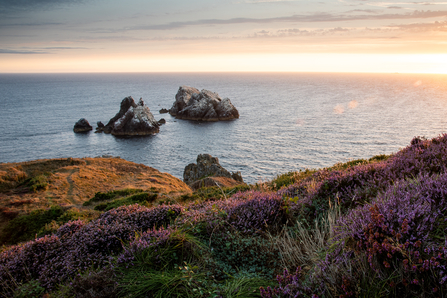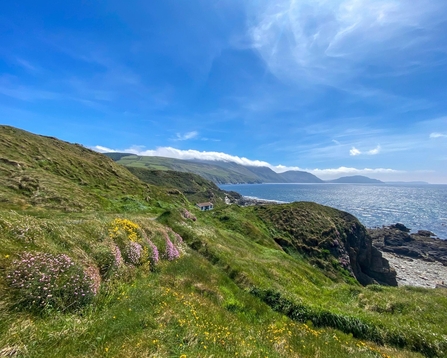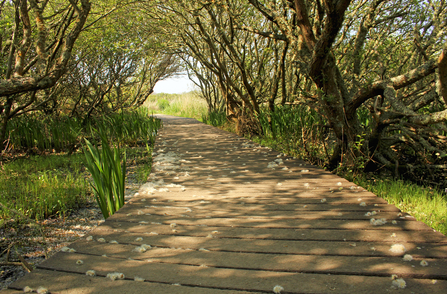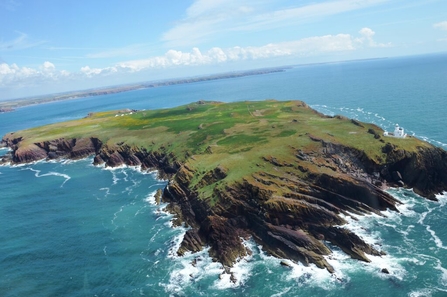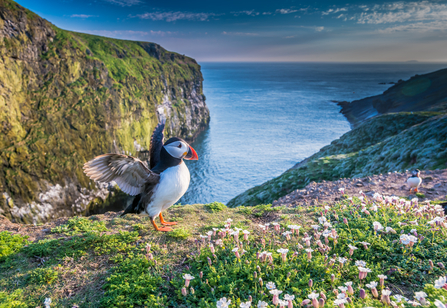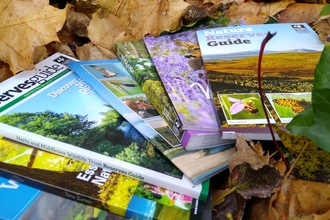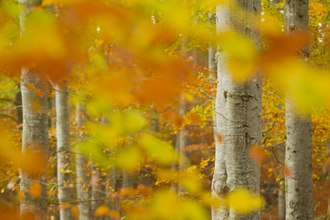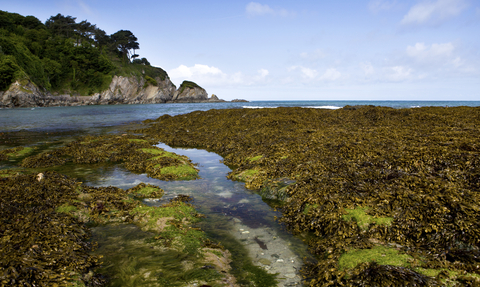
©Toby Roxburgh/2020VISION
The Wildlife Trusts’ Incredible Islands
There are forty-six individual Wildlife Trusts, and this includes 5 Trusts which are either entirely island based, or partly island based. These islands hold unique wildlife and wild places that don’t appear on the mainland. Below you can find more information about what makes these areas so special, and why they're such amazing places to visit.
Alderney Wildlife Trust
Alderney consists of an archipelago of small islands, with one main landmass (Alderney itself) and numerous islets and reefs. In turn, this chain of islands encloses 60km² of sea which belongs outright to the island and its resident community.
Alderney is home to a vast range of bird species including Atlantic puffins and Northern gannets. Les Etacs is home to a few thousand pairs of breeding gannets and can be viewed while walking along the Gorse-covered Southern cliffs of the island, while you can visit Ortac and our Puffin colony on Burhou by boat. All kinds of plant life can be found as well! From the bright yellow Prostrate Broom on the south cliffs, to the amazing purple of bell and common heather in Mannez Quarry. If you love exploring underwater, Alderney has some great spots, such as Longis Bay which is ideal for swimming, kayaking and exploring rock pools.
Alderney has almost every kind of habitat and is a paradise for all kinds of insects, including a plethora of bees, butterflies, moths and beetles, including species rarely seen in the UK such as the Glanville Fratilarry and Large Tortoiseshell butterfly. We are proud of the statistic that there are apparently more species of moth to be found in our small island than in any equivalent area in the British Isles. Our island is rich in history and wildlife and is waiting to be explored.
Isle of Man (Manx Wildlife Trust)
A jewel in the Irish Sea, the Isle of Man hosts stunning habitats, beautiful wildlife and spectacular scenery. From open heather moorland which adorns the uplands right to the top of Snaefell, the Island’s highest point at 2034 ft, to low-lying willow and alder carr woodland (called curragh on the Island) in the valleys.
The Island contains a wide variety of habitats, home to a range of wildlife including a vast diversity of habitats for coastal and sea birds. There are spectacular cliffs, wide sandy beaches, a unique lichen heath, coastal grasslands and some salt marsh. Beaches backed by sand dunes, maritime heath, gravel pits and freshwater ponds provide complex habitats for birds.
The Island has a busy marine scene too, dolphins and sharks can often be seen off the Island's coastline. Several species have been recorded in the Irish sea, the most common cetaceans seen around the Isle of Man are the harbour porpoise, Risso’s dolphin and bottlenose dolphin. Also, not to be forgotten, seals can be seen around our coast all year, especially around the Calf of Man, a small islet off the south coast managed as a nature reserve and bird observatory. The two species seen are the Atlantic grey seal, which are the most common, and the Common seal.
Isles of Scilly Wildlife Trust
Over 50% of Scilly is looked after by the Isles of Scilly Wildlife Trust; that means nature has space to thrive! Space for nature means space for people too; the majority of the land is open for all to enjoy - some access restrictions are in place for the benefit of Scilly’s wildlife, please do adhere to them.
Whilst exploring the 678 hectares that are managed for nature and people, you can spot a wide variety of different plant and animal species. Rare plant species continue to increase as a result of the Trusts management and habitat restoration; including Bog pimpernel, which has returned to Higher Moors SSSI after 68 years of absence; Tubular water dropwort which, although vulnerable & rapidly declining in the UK, increased by over 2000% in 2019 on the Islands.
Animal species in Scilly also appear to be benefiting from the work of the Trust with 45 "stargazing" Manx shearwater chicks being recorded on St Agnes & Gugh during 2019 (an increase from 0 recorded in 2013). Additionally, 5 new Bat roosts have been confirmed on the islands along with a new species for Scilly (Leisler's bat).
The Trust Rangers cut and keep clear over 40,000 metres of permissive paths across the archipelago, annually; enabling visitors to enjoy many walks, on both inhabited and uninhabited Islands, whilst minimising disturbance to wildlife. Since 2015 the Trust has also replaced nearly 300m of old wooden boardwalk with recycled plastic boardwalk improving paths across Scilly’s vitally important wetland sites, both Higher & Lower Moors.
Isle of Wight (part of Hampshire and Isle of Wight Wildlife Trust)
Hampshire & Isle of Wight Wildlife Trust manage over 50 nature reserves and work with other organisations and landowners to protect and connect wildlife sites across the two counties. The Trust's work began on the Isle of Wight in 1971, and there are now 16 reserves on the island, with fantastic wildlife experiences to be had throughout the year.
In February you can spot the wintering wildfowl and waders visiting form the north and east on our wetland sites in the East Yar valley. Sites such as Sandown Meadows and Morton Marsh are great for wildfowl including Teal, Shoveler, Wigeon, Gadwall and waders such as lapwing and snipe.
In July there are a range of butterflies on the wing, particularly blues including, Adonis, small, and common blues but one of the most amazing wildlife spectacles can be seen if you visit Arreton Down on a sunny day to see the Chalk hill blues. In late July the Down is awash with chalk hill blues moving like a carpet across the Down and surely one of the greatest sites for the species in the UK.
Moving to September, this is the best time to catch a glimpse of a red squirrel as they begin to forage and stash nuts. The Isle of Wight is one of only a handful of places in England where there are no grey squirrels to out-compete their cousins, meaning reds are flourishing. With distinctive russet fur, tufted ears and twitching tail, a native red squirrel is a captivating sight. A good bet is to visit Bouldnor Forest nature reserve, where red squirrels thrive.
Skokholm Island (part of The Wildlife Trust of South and West Wales)
Lying in the Celtic Sea two miles off the south west Pembrokeshire coast, Skokholm has its own charm and sense of remoteness with tall, sandstone cliffs and a wild landscape. The island is approximately half a mile across at its widest point and a mile in length which makes it perfect for exploring. Spring and summer it is colonised by tens of thousands of nesting seabirds returning to their island home.
By day there is frenetic activity among the Puffins, Razorbills, Guillemots and gulls and by night there is a more vocal but equally hectic commotion from the Manx Shearwaters and Storm Petrels. The island is awash with salt-loving maritime flora especially in May and June. Swathes of pink Thrift, and white Sea Campion, carpet the green plateau of the island. The invertebrate fauna is just as exciting, containing many nationally rare species such as Black Banded and Devonshire Wainscot moths. As well as this, grey seals are present in the waters around the Island throughout the year, and are regularly seen basking on rocks at low water.
Skomer Island (part of The Wildlife Trust of South and West Wales)
Located less than a mile off the beautiful Pembrokeshire coast, Skomer island is truly a wonderful place to visit for the day or stay overnight. The island provides a fantastic habitat for ground nesting birds. An accurate census of puffins is difficult, but a count in 2020 indicated over 34,796. Manx shearwaters also do well on the island. There are an estimated 316,000 breeding pairs on Skomer, with Skokholm Islands breeding pairs this makes the two islands the largest known concentration of this species in the world. The waters around the island are also home to some incredible marine wildlife such as dolphins and seals.
Skomer Island has something to offer everyone. Surrounded by shaded inlets, off shore rocks and sheltered coves, Skomer is an island full of mystery, discovery, wildlife and adventure…it’s a unique island just waiting to be explored! No matter what time of year you visit, the island’s flora and fauna will leave you breathless with excitement and wishing you could stay for longer. Keep an eye out for the famous Skomer Vole, thousands of Rabbits and our resident birds of prey – Buzzards, Peregrine Falcons and Owls.







